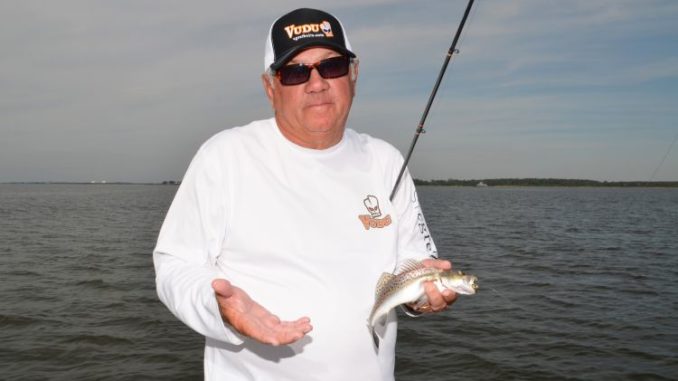
Sixty-two-year-old Ken Chaumont lives north of Iowa (pronounced EYE-oh-way), Louisiana. The Lake Charles native moved to the country because in his own words, he hated boom boxes. “I like peace and quiet.”
Fishing started with his father Edwin on Calcasieu River in a cypress flatboat. “They weighed about 700 pounds,” he chuckled with his exaggeration. The boat was powered by a white 6-horse Mercury (can you remember those?) outboard.
“We fished for fish — any fish! And we absolutely ate our fish.”
Chaumont remembers drifting with a sculling paddle, armed with cane poles and live bait. They left the dock with no bait, instead bringing a bait seine. “What we caught is what we used.
“We picked catalpa (pronounced country style as ka-TAB-la) worms. We would grow our own earthworms in an old door-less refrigerator filled with dirt. We fed them table scraps. Dad raised blow fly maggots by mixing kitchen garbage, especially rice and gravy, with dirt.”
The Chaumonts had a camp in Indian Village, near the Calcasieu River, 7 miles below Kinder. “Four families built it, mostly from scrap materials. It was pretty rough — nothing fancy.
“It had no air conditioning, but was set in the shade under trees and had screens in the windows. We bathed in the river every evening using white Ivory soap, because the bar floated if you dropped it.
“About 10 or 11, I started using rods and reels and artificials — a silver push-button Zebco and Beetle Spins and Lucky 13s. I always had Crème worms on three-hook rigs with spinners in front in my box.”
Then Toledo Bend Reservoir caught their eye. They started fishing it from an “old green tent.” When Chaumont was 14, his father bought a camp on the lake. “From 14 to 20, I wanted to be a professional bass fisherman.
“Toledo Bend would do that to you. One-hundred-fish days were common. I was ate up with the fishing industry.”
At 15, his father had a serious heart attack and had to retire. Chaumont started working to help his parents. He often worked two jobs at a time — baseball umpire, life guard, restaurant waiter, yard mower — whatever paid him.
At 21, he married Pam Reed and went to work at CITGO Refinery as an operator. “I couldn’t stand it,” he growled about the experience.
From there it was to Lanier selling copy machines on straight commission. “It dawned on me there that I could work when I wanted to. So I worked really hard Mondays through Thursdays and fished Friday, Saturday, and Sunday.
“Then I stopped working on Mondays and fished. Tuesdays came next — all bass fishing, strictly Toledo Bend.
“My poor wife,” he lamented.
Two years later he left the copy machine business to produce and sell radio jingles and television commercials. This expanded into a part ownership of Admark, an ad agency.
“Some of my biggest customers were shooting and fishing shows. Through this, I met Bill Lewis, owner of Bill Lewis Lures, most famous for their Rat-L-Trap lures. I did his first catalog.
“He hired me as a market consultant. The company skyrocketed from $1 million in sales to $10 million in 6 years. For 15 years, I handled all the public relations work with the Outdoor Writers Association of America, the Southeastern Press Association, the Louisiana Outdoor Writers Association, Field & Stream, Outdoor Life.”
That ended about 2003. Chaumont was 49 years old.
At that stage in his life, he still mostly bass fished, but would make occasional saltwater excursions to Calcasieu Lake. While he was at Bill Lewis Lures, they began toying with saltwater Rat-L-Traps.
“The gold Rat-L-Trap will catch redfish like no tomorrow,” he shook his head, as if in wonder. “It’s one of the best redfish baits ever.”
Also while working at Bill Lewis Lures, he met Walter Umphrey, a Texas cattleman and attorney. In partnership, they bought Stanley Jigs, a “nearly broke” company and rebuilt it. To grow Stanley, they also bought Ribbit Frogs.
In 2010, the partners sold Stanley and the frog company, but retained Wedgetail Plastics, which they had purchased from the inventor, Bill King.
“The manufacturer showed me a D.O.A. Shrimp and asked about making something similar for us. I didn’t want to build a D.O.A.-lookalike. I wanted something more realistic.
“I wanted it hand-poured, not injected. I wanted it pre-rigged out of the box. I wanted a durable plastic.
“The factory engineer suggested using thermoplastic elastomer. Its biggest sales points are its durability first and it’s appearance second. The Vudu Shrimp was born from the concept.
“The lure I have on my rod right here has been on for 6 months and I fish an average of 3 times a week. The first thing that goes is not the plastic, but rather the tip of the hook, which becomes rusty.
Chaumont is majority and managing partner of Egret Baits, which owns Vudu lures. Company operations are based in Many, next to Toledo Town & Tackle, right in the middle of largemouth bass country.
Chaumont now owns a camp at Hebert’s Landing on Calcasieu Lake. Eighty to 90 percent of his fishing these days is saltwater. “I own a saltwater bait company,” he shrugged happily.